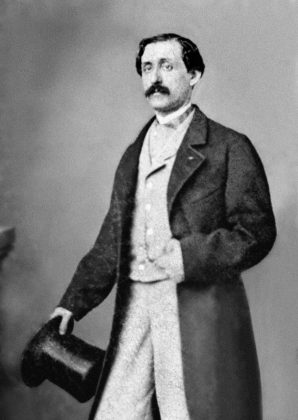
Louis Moreau Gottschalk, an American composer and pianist, was born on May 8, 1829, in New Orleans, Louisiana. His father, Edward Gottschalk, was a London-born Jewish businessman of German origin, while his mother, Aimée Marie Bruslé, was a Creole of French ancestry. This multicultural background played a significant role in shaping Gottschalk’s musical style in his later years.
Gottschalk was exposed to a diverse array of musical traditions from a young age. His family resided briefly in a quaint cottage at Royal and Esplanade in the Vieux Carré area, and later he moved in with relatives at 518 Conti Street. His maternal grandmother and nurse, both Saint Dominican Creoles, nurtured his early musical education. Gottschalk’s fascination with the piano started at an early age, and he exhibited prodigious talent that was quickly recognized by the New Orleans bourgeois community.
Gottschalk’s Musical Journey Begins
Gottschalk’s informal public debut took place in 1840 at the St. Charles Hotel, a grand establishment in New Orleans. Barely two years later, the 13-year-old Gottschalk and his father embarked on a journey to Europe, acknowledging the need for classical training to fulfill his musical ambitions. Their destination was Paris, the heart of the European music scene.
However, the Paris Conservatoire rejected Gottschalk’s application without an audition, citing his American nationality as the reason. Pierre Zimmerman, head of the piano faculty, dismissed America as a “country of steam engines.” Despite this setback, Gottschalk managed to secure private music lessons through family friends and began creating a name for himself in the European music world.
Triumph over Trials: Gottschalk’s Rise in Europe
Gottschalk’s early compositions, such as “Bamboula” and “La Savane,” were groundbreaking in their fusion of European classical music tradition with American elements. These works carried a legacy of indigenous music within a romantic music context, and they are considered precursors of jazz. They also stand as the first examples of Louisiana Creole music in classical music culture.
Gottschalk’s concerts were a sensation in Europe, with luminaries such as Frédéric Chopin and Franz Liszt among his admirers. After a concert at the Salle Pleyel, Chopin reportedly told Gottschalk, “Give me your hand, my child; I predict that you will become the king of pianists.” This recognition from the masters of European music helped solidify Gottschalk’s reputation as a promising young composer and pianist.
Return to America: Challenges and Triumphs
Gottschalk returned to the United States in 1853, hoping to replicate his European success. Although he was initially met with lukewarm reception, he persevered, traveling extensively and performing at numerous venues. A significant part of his journey included a sojourn in Cuba in 1854, marking the beginning of a series of trips to Central and South America.
Despite being born and raised in New Orleans, Gottschalk was a staunch Union supporter during the American Civil War. He always introduced himself as a New Orleanian, and his music often reflected his Creole roots. His composition “Grande Tarantelle, Op. 67,” subtitled “Célèbre Tarentelle,” created between 1858 and 1864, echoes his Creole heritage.
Scandal and Exile
In 1865, Gottschalk’s career took a dramatic turn. A scandal involving an alleged affair with a student at the Oakland Female Seminary in California forced him to leave the United States. Despite his denial of any wrongdoing, the scandal tarnished Gottschalk’s reputation, and he never returned to the United States.
Choosing South America as his new home, Gottschalk continued to perform frequently. His concerts were well-received, and he found a new audience for his unique blend of American and European musical styles.
Tragic End and Lasting Legacy
Gottschalk’s life was cut tragically short on December 18, 1869, when he collapsed from yellow fever during a concert at the Teatro Lyrico Fluminense in Rio de Janeiro, Brazil. Just before his collapse, he had finished playing his romantic piece “Morte!” (She is Dead). Gottschalk never recovered from this collapse, dying at the age of 40 at his hotel in Tijuca, Rio de Janeiro.
Gottschalk’s remains were returned to the United States and interred at the Green-Wood Cemetery in Brooklyn, New York. His burial spot was originally marked by a magnificent marble monument, topped by an “Angel of Music” statue, which was later damaged by vandals. After a successful fundraising campaign, a new “Angel of Music” statue was unveiled in 2012.
Gottschalk’s Musical Contributions
Gottschalk’s music, popular during his lifetime, was a harmonious blend of European-style music with Cuban, Creole, and popular melodies and rhythms of the Americas. His compositions, such as “Bamboula,” “La Savane,” “Le Bananier,” and “Le Mancenillier,” were inspired by the music he heard during his youth in Louisiana and were regarded as the earliest examples of Creole music in classical culture.
Gottschalk was also successful as a composer of salon music, and his sentimental pieces like “The Dying Poet” were favorites of many amateur pianists. His most famous work in this vein is “The Last Hope, Religious Meditation,” which enjoyed enormous success during his lifetime.
Although Gottschalk’s salon compositions are considered musically shallow and insignificant compared to his more distinctive American ethnic music, his work has seen a revival in recent years. Musicians, critics, and the general public have rediscovered the innovation and sophistication of Gottschalk’s unique musical voice, leading to a renewed interest in his works.
Gottschalk’s Influence on American Music
Gottschalk is considered the first American composer to erase the hard line dividing ‘serious’ and ‘popular’ genres. He was the first to introduce American themes into European classical music and the first Pan-American artist in any field. He was among the first American artists to champion abolitionism, public education, and popular democracy.
Gottschalk’s greatest contribution to American music was the incorporation of the syncopated rhythmic elements of Caribbean and Latin folk music into his compositions. His rhythmic elements “anticipate ragtime and jazz by a half-century,” making him an instrumental figure in the evolution of American music.
Louis Moreau Gottschalk’s life was a testament to his extraordinary talent and his unwavering dedication to his craft. His musical compositions, an amalgamation of European classical music and the vibrant rhythms and melodies of the Americas, remain a unique contribution to the world of music. Despite his untimely death, Gottschalk’s musical legacy continues to inspire and influence musicians and music lovers alike, proving that his music is truly timeless.
